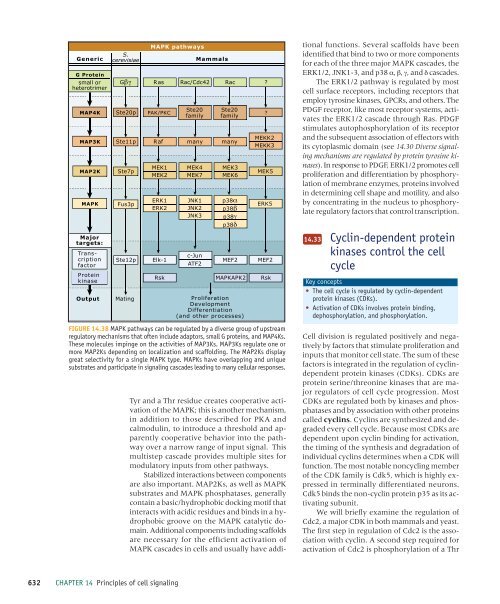Principles of cell signaling - UT Southwestern
Principles of cell signaling - UT Southwestern
Principles of cell signaling - UT Southwestern
You also want an ePaper? Increase the reach of your titles
YUMPU automatically turns print PDFs into web optimized ePapers that Google loves.
39057_ch14_<strong>cell</strong>bio.qxd 8/28/06 5:11 PM Page 632<br />
Generic<br />
G Protein<br />
small or<br />
heterotrimer<br />
MAP4K<br />
MAP3K<br />
MAP2K<br />
MAPK<br />
Major<br />
targets:<br />
Transcription<br />
factor<br />
Protein<br />
kinase<br />
Output<br />
S.<br />
cerevisiae<br />
Gβγ<br />
Ste20p<br />
Ste11p<br />
Ste7p<br />
Fus3p<br />
Ste12p<br />
Mating<br />
MAPK pathways<br />
Mammals<br />
Ras Rac/Cdc42 Rac<br />
?<br />
Ste20 Ste20<br />
PAK/PKC ?<br />
family family<br />
Raf<br />
MEK1<br />
MEK2<br />
ERK1<br />
ERK2<br />
Elk-1<br />
Rsk<br />
many<br />
MEK4<br />
MEK7<br />
JNK1<br />
JNK2<br />
JNK3<br />
c-Jun<br />
ATF2<br />
many<br />
MEK3<br />
MEK6<br />
p38α<br />
p38β<br />
p38γ<br />
p38δ<br />
MEF2<br />
MAPKAPK2<br />
Proliferation<br />
Development<br />
Differentiation<br />
(and other processes)<br />
MEKK2<br />
MEKK3<br />
MEK5<br />
ERK5<br />
MEF2<br />
FIGURE 14.38 MAPK pathways can be regulated by a diverse group <strong>of</strong> upstream<br />
regulatory mechanisms that <strong>of</strong>ten include adaptors, small G proteins, and MAP4Ks.<br />
These molecules impinge on the activities <strong>of</strong> MAP3Ks. MAP3Ks regulate one or<br />
more MAP2Ks depending on localization and scaffolding. The MAP2Ks display<br />
great selectivity for a single MAPK type. MAPKs have overlapping and unique<br />
substrates and participate in <strong>signaling</strong> cascades leading to many <strong>cell</strong>ular responses.<br />
Rsk<br />
Tyr and a Thr residue creates cooperative activation<br />
<strong>of</strong> the MAPK; this is another mechanism,<br />
in addition to those described for PKA and<br />
calmodulin, to introduce a threshold and apparently<br />
cooperative behavior into the pathway<br />
over a narrow range <strong>of</strong> input signal. This<br />
multistep cascade provides multiple sites for<br />
modulatory inputs from other pathways.<br />
Stabilized interactions between components<br />
are also important. MAP2Ks, as well as MAPK<br />
substrates and MAPK phosphatases, generally<br />
contain a basic/hydrophobic docking motif that<br />
interacts with acidic residues and binds in a hydrophobic<br />
groove on the MAPK catalytic domain.<br />
Additional components including scaffolds<br />
are necessary for the efficient activation <strong>of</strong><br />
MAPK cascades in <strong>cell</strong>s and usually have additional<br />
functions. Several scaffolds have been<br />
identified that bind to two or more components<br />
for each <strong>of</strong> the three major MAPK cascades, the<br />
ERK1/2, JNK1-3, and p38 α, β, γ, and δ cascades.<br />
The ERK1/2 pathway is regulated by most<br />
<strong>cell</strong> surface receptors, including receptors that<br />
employ tyrosine kinases, GPCRs, and others. The<br />
PDGF receptor, like most receptor systems, activates<br />
the ERK1/2 cascade through Ras. PDGF<br />
stimulates autophosphorylation <strong>of</strong> its receptor<br />
and the subsequent association <strong>of</strong> effectors with<br />
its cytoplasmic domain (see 14.30 Diverse <strong>signaling</strong><br />
mechanisms are regulated by protein tyrosine kinases).<br />
In response to PDGF, ERK1/2 promotes <strong>cell</strong><br />
proliferation and differentiation by phosphorylation<br />
<strong>of</strong> membrane enzymes, proteins involved<br />
in determining <strong>cell</strong> shape and motility, and also<br />
by concentrating in the nucleus to phosphorylate<br />
regulatory factors that control transcription.<br />
14.33<br />
Cyclin-dependent protein<br />
kinases control the <strong>cell</strong><br />
cycle<br />
Key concepts<br />
• The <strong>cell</strong> cycle is regulated by cyclin-dependent<br />
protein kinases (CDKs).<br />
• Activation <strong>of</strong> CDKs involves protein binding,<br />
dephosphorylation, and phosphorylation.<br />
Cell division is regulated positively and negatively<br />
by factors that stimulate proliferation and<br />
inputs that monitor <strong>cell</strong> state. The sum <strong>of</strong> these<br />
factors is integrated in the regulation <strong>of</strong> cyclindependent<br />
protein kinases (CDKs). CDKs are<br />
protein serine/threonine kinases that are major<br />
regulators <strong>of</strong> <strong>cell</strong> cycle progression. Most<br />
CDKs are regulated both by kinases and phosphatases<br />
and by association with other proteins<br />
called cyclins. Cyclins are synthesized and degraded<br />
every <strong>cell</strong> cycle. Because most CDKs are<br />
dependent upon cyclin binding for activation,<br />
the timing <strong>of</strong> the synthesis and degradation <strong>of</strong><br />
individual cyclins determines when a CDK will<br />
function. The most notable noncycling member<br />
<strong>of</strong> the CDK family is Cdk5, which is highly expressed<br />
in terminally differentiated neurons.<br />
Cdk5 binds the non-cyclin protein p35 as its activating<br />
subunit.<br />
We will briefly examine the regulation <strong>of</strong><br />
Cdc2, a major CDK in both mammals and yeast.<br />
The first step in regulation <strong>of</strong> Cdc2 is the association<br />
with cyclin. A second step required for<br />
activation <strong>of</strong> Cdc2 is phosphorylation <strong>of</strong> a Thr<br />
632 CHAPTER 14 <strong>Principles</strong> <strong>of</strong> <strong>cell</strong> <strong>signaling</strong>
















